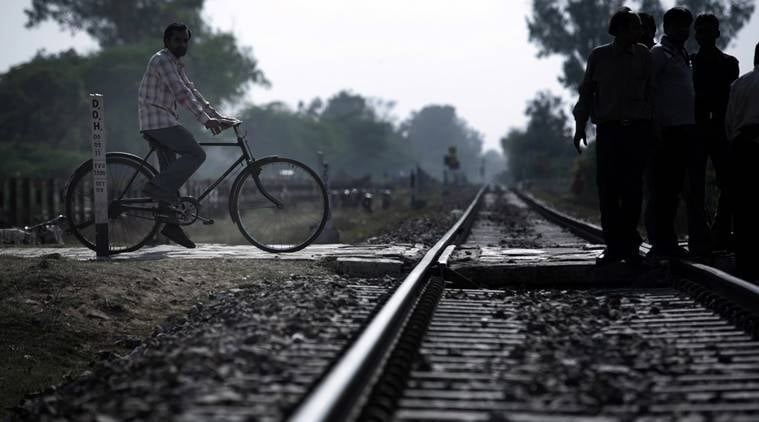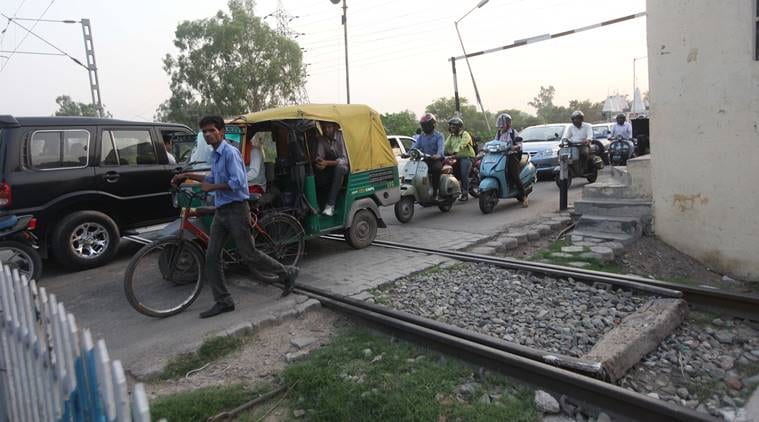 The Indian Railways has eliminated 1464 unmanned level crossings in the last year. As of March 31, 2018, there are 3,479 unmanned level crossings in the country. (Source: Express Photo by Praveen Khana)
The Indian Railways has eliminated 1464 unmanned level crossings in the last year. As of March 31, 2018, there are 3,479 unmanned level crossings in the country. (Source: Express Photo by Praveen Khana)
The deaths of 13 schoolchildren at an unmanned level crossing in Uttar Pradesh has everyone once again asking the age-old question: “Whose fault is it anyway?” While Indian Railway Board chairman Ashwini Lohani set March 31, 2020, as the deadline for eliminating unmanned level crossings across the country, he put the onus on road users to look both ways before crossing railway tracks. “Basically, people have to be careful while crossing rail tracks, there is no substitute for that. We can’t take any step that is foolproof against negligence,” Lohani said.
He is right. It is, in fact, written in stone: “As per Section 131 of Motor Vehicle Act and Section 161 of Indian Railway Act, the onus for safe movement over UMLC has been put entirely on the road users.” Despite the precautionary measures undertaken by the railways to avoid loss of life, at least 29 people died between 2016-17 in accidents at unmanned level crossings. However, the number of accidents and deaths have been on a decline since 2014. In 2014-15, the number of UMLC accidents stood at 50 and 130 people died. The next year, the number of those who were killed (58) was less than half of what previously was. In 2016-17, the accidents (14) and victims (29) were significantly fewer. The number of unmanned level crossings also came down significantly in the last two years.
As of April 2016, the total number of unmanned level crossings across the country was 9,340. The number of unmanned level crossings manned between 2014-16 stood at 890. Uttar Pradesh was second with 1,357 unmanned level crossings while Gujarat led the list of states with the highest number of unmanned level crossing with 1,985. During this period 124 unmanned level crossings in Uttar Pradesh were manned.
 The railways is moving aggressively to meet the 2020 deadline it had set itself where all unmanned level crossings will be eliminated. (Source: Express photo by Jaipal Singh)
The railways is moving aggressively to meet the 2020 deadline it had set itself where all unmanned level crossings will be eliminated. (Source: Express photo by Jaipal Singh)
How do the railways take the decision to man level crossings?
The railways allot something called the Train Vehicle Units (TVU) figure for every level crossing. It is calculated based on traffic density and train movement at a level crossing in 24 hours. If 200 vehicles pass through a railways crossing in 24 hours on a route which has 10 trains plying, then the TVU for that level crossing is 2000 (number of vehicles multiplied by number of trains). The TVU for the level crossing in Khushinagar was less than 2000, which is quite low, said Lohani. The board’s approval is not required For manning of unmanned level crossings with traffic density more than 10000 TVUs.
According to an updated Permanent Way Manual of the Indian Railways, unmanned level crossings have been categorized into five categories for manning them in a phased manner.
“Category-I Level Crossings where the Train Vehicle Units (TVUs) exceed 10000.
Category-II Level Crossings where TVUs exceed 6000 and where visibility is restricted.
Category-III Level Crossings where TVUs is less than 6000 and visibility is restricted but buses, motor vehicles ply regularly.
Category-IV Level Crossings where TVU is less than 6000 and visibility is restricted but motor vehicles do not ply.
Category-V Level crossings where visibility is adequate but traffic density exceeds 6000 TVUs.(Advance Correction Slip No. 115)
 The mangled remains of an auto at an unmanned crossing in Ferozpur. (Source: file/Express photo)
The mangled remains of an auto at an unmanned crossing in Ferozpur. (Source: file/Express photo)
The Indian Railways has eliminated 1464 unmanned level crossings in the last year. As of March 31, 2018, there are 3,479 unmanned level crossings in the country. The railways is moving aggressively to meet the 2020 deadline it had set itself where all unmanned level crossings will be eliminated. All unmanned level crossings will either be converted to manned crossings or the railways will undertake construction of over or under bridges to bypass such crossings. The railways has already launched “Gate Mitra” initiative to alert road users about approaching trains and prevent accidents at unmanned level crossing gates.
This, however, couldn’t prevent the collision at Kushinagar. The driver of the school allegedly ignored the warnings of a Gate Mitra and attempted to pass the crossing before the train came charging down the track. As Lohani said, there is no way to foolproof against negligence.